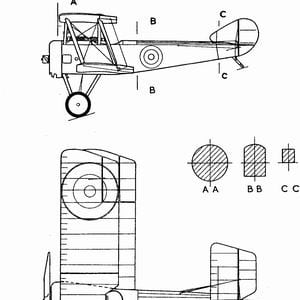Sopwith Pup History
Developed by Herbert Smith from a personal aircraft flown by Harry Hawker in 1915, the Sopwith Pup looked like a scaled-down offspring of the earlier Sopwith 1½ Strutter: hence its nickname, which persisted in spite of Admiralty orders to the contrary. The Pup was classically simple in appearance and construction, and had flying qualities which earned the descriptions ‘perfect’ and ‘impeccable’. Its simplicity belied its ruggedness, and for 80 hp the Pup offered a remarkable performance and excellent manoeuvrability.
Although the bulk of later production was to Royal Flying Corps (RFC) orders, the Pup’s origins and later associations lay mainly with the Royal Navy. The first of six Sopwith Pup prototypes was flown in February 1916, and the type underwent Admiralty service trials three months later. Initial orders were placed with Sopwith and Beardmore, and after the first few Beardmore machines the Le Rhône 9 C engine was standardised.
Royal Naval Air Service (RNAS) Pups were referred to officially as Admiralty Type 9901 and were at first armed with one 0.303 in Vickers gun mounted centrally in front of the pilot; these were synchronised with various gears throughout the Pup’s service career. Eight Le Prieur rockets were an alternative armament, but were used comparatively little on Royal Navy Pups, although some were seen with rockets and a Vickers gun.
Deliveries commenced in autumn 1916, the first unit to receive Sopwith Pups being No. 1 Wing RNAS. Beardmore and Sopwith built one hundred and seventy Pups for the Navy, while Whitehead Aviation and the Standard Motor Co. completed a further one thousand six hundred and seventy for the RFC.
Pups operated on the Western Front in late 1916/early 1917; in October 1916 the famous ‘Naval 8’ Squadron was formed to assist the RFC. Initially only one of No. 8’s flights was equipped with Pups, but latter all three flights (eighteen aircraft) had them. In the two final months of 1917 the Pups of No. 8 accounted for twenty enemy aircraft. From the beginning of 1918, although production had still not reached its peak, the Sopwith Pup began to be withdrawn from the front-line units.
Later in their career, some Pups (with 100 hp Gnome Monosoupape engines) were employed on home defence duties. The total Sopwith Pup production was 1,770, of which some 290 served with the RNAS. Some of these were Type 9901as, modified to suit them for operation from aircraft carriers; these had skid undercarriages. Beardmore also developed the W.B.III, with folding wings and retractable undercarriage. Of 100 W.B.IIIs ordered, 55 were in service by the end of the war.
After the war the Sopwith Pup disappeared quickly from the British scene. Only eight found their way to the civil register, all of which had disappeared by 1924. Eleven were supplied to the Royal Australian Air Force in 1919, and small numbers also went to the United States, Greece, the Netherlands and Russia.










